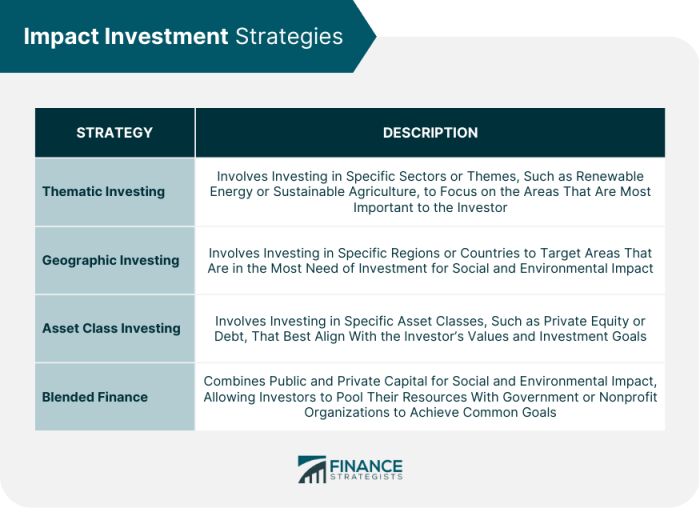
With Impact Investing Strategy at the forefront, this paragraph opens a window to an amazing start and intrigue, inviting readers to embark on a storytelling casual formal language style filled with unexpected twists and insights.
Impact investing is not just about financial gains, but also about making a positive impact on society and the environment. Understanding this strategy can lead to a more sustainable and purposeful way of investing.
Introduction to Impact Investing Strategy
Impact investing is a financial strategy that aims to generate positive social or environmental impact alongside financial returns. This approach has gained significant traction in recent years as investors seek to align their values with their investment decisions. Impact investing differs from traditional investment approaches by prioritizing the intention to create positive change while still aiming for financial profitability.
Primary Goals of Impact Investing
- Addressing social or environmental challenges
- Promoting sustainable development
- Supporting underserved communities
Examples of Sectors for Impact Investing
- Clean energy
- Healthcare access
- Education initiatives
Factors Influencing Impact Investing Strategy
Impact investing strategies are shaped by a variety of factors that influence how investors make decisions in this space.
Market Trends and Societal Demands
Market trends and societal demands play a significant role in impacting investment decisions. As the market shifts towards sustainable and socially responsible practices, investors are increasingly considering the environmental and social impact of their investments. This shift is driven by consumer demand for transparency and accountability from companies, as well as regulatory changes that prioritize sustainability.
Ethical Considerations
Ethical considerations are another key factor in shaping impact investing strategies. Investors are increasingly concerned with aligning their investments with their values and ethical beliefs. This includes avoiding industries or companies that engage in practices deemed harmful to society or the environment, and actively seeking out opportunities to support causes they believe in.
Risk Assessment in Impact Investing
Risk assessment in impact investing differs from traditional investments in that it involves evaluating not only financial risks, but also social and environmental risks. Investors need to consider the potential impact of their investments on communities, ecosystems, and society as a whole. This requires a more holistic approach to risk assessment that takes into account a broader range of factors beyond financial returns.
Implementing an Impact Investing Strategy

Implementing an impact investing strategy involves a series of steps to ensure that investments are aligned with social and environmental goals.
Setting Measurable Goals and Benchmarks
One key aspect of implementing an impact investing strategy is setting measurable goals and benchmarks. This helps investors track progress, evaluate impact, and make informed decisions.
- Establish clear objectives that define the social or environmental outcomes you aim to achieve.
- Create specific metrics and benchmarks to measure progress towards these goals.
- Regularly monitor and evaluate the impact of investments against these predetermined targets.
Evaluating Social and Environmental Impact
Impact investors assess the social and environmental impact of their investments through various methods.
- Conducting impact assessments to measure the positive effects on communities or ecosystems.
- Engaging with stakeholders to gather feedback and insights on the impact of investments.
- Using data and analytics to quantify and evaluate the outcomes achieved through investments.
Tools and Frameworks for Assessing Impact
There are several tools and frameworks available to help impact investors assess the effectiveness of their strategies.
- Impact Measurement and Management (IMM): A framework that provides guidelines for measuring, managing, and optimizing impact.
- Global Reporting Initiative (GRI): A reporting framework that helps organizations disclose their social and environmental impacts.
- Environmental, Social, and Governance (ESG) Criteria: Criteria used to evaluate the sustainability and ethical impact of investments.
Investment Advice and Strategies

Investment advisors play a crucial role in guiding clients on impact investing strategies, helping them navigate the complex landscape of socially responsible investments. These professionals provide expertise, research, and recommendations tailored to each client’s unique financial goals and values.
Role of Investment Advisors in Impact Investing
- Investment advisors help clients identify impact investment opportunities that align with their values and financial objectives.
- They conduct thorough research to assess the potential risks and returns of different impact investing strategies.
- Advisors provide personalized recommendations based on the client’s risk tolerance, time horizon, and desired impact outcomes.
Examples of Successful Impact Investing Strategies
- One successful strategy recommended by advisors is investing in renewable energy projects to support environmental sustainability while generating financial returns.
- Another example is investing in companies with strong social impact initiatives, such as those focused on education or healthcare, to create positive change in communities.
Ongoing Monitoring and Adjustments
It is essential for investment advisors to continuously monitor the performance of impact investing portfolios and make adjustments as needed. This includes staying informed about market trends, regulatory changes, and the evolving landscape of impact investing opportunities.
In conclusion, Impact Investing Strategy offers a unique opportunity to align financial goals with social and environmental impact. By carefully considering various factors and implementing a well-thought-out strategy, investors can contribute to positive change while still achieving financial success.
Key Questions Answered
What is impact investing?
Impact investing involves making investments that generate positive social or environmental impact alongside financial returns.
How does impact investing differ from traditional investments?
Unlike traditional investments that focus solely on financial gains, impact investing aims to create positive change in addition to profitability.
What are some common sectors for impact investing?
Sectors like renewable energy, education, healthcare, and affordable housing are commonly targeted for impact investing due to their social and environmental significance.
How do investors assess risk in impact investing?
Risk assessment in impact investing involves considering not just financial risks but also the potential social and environmental impacts of investments.





